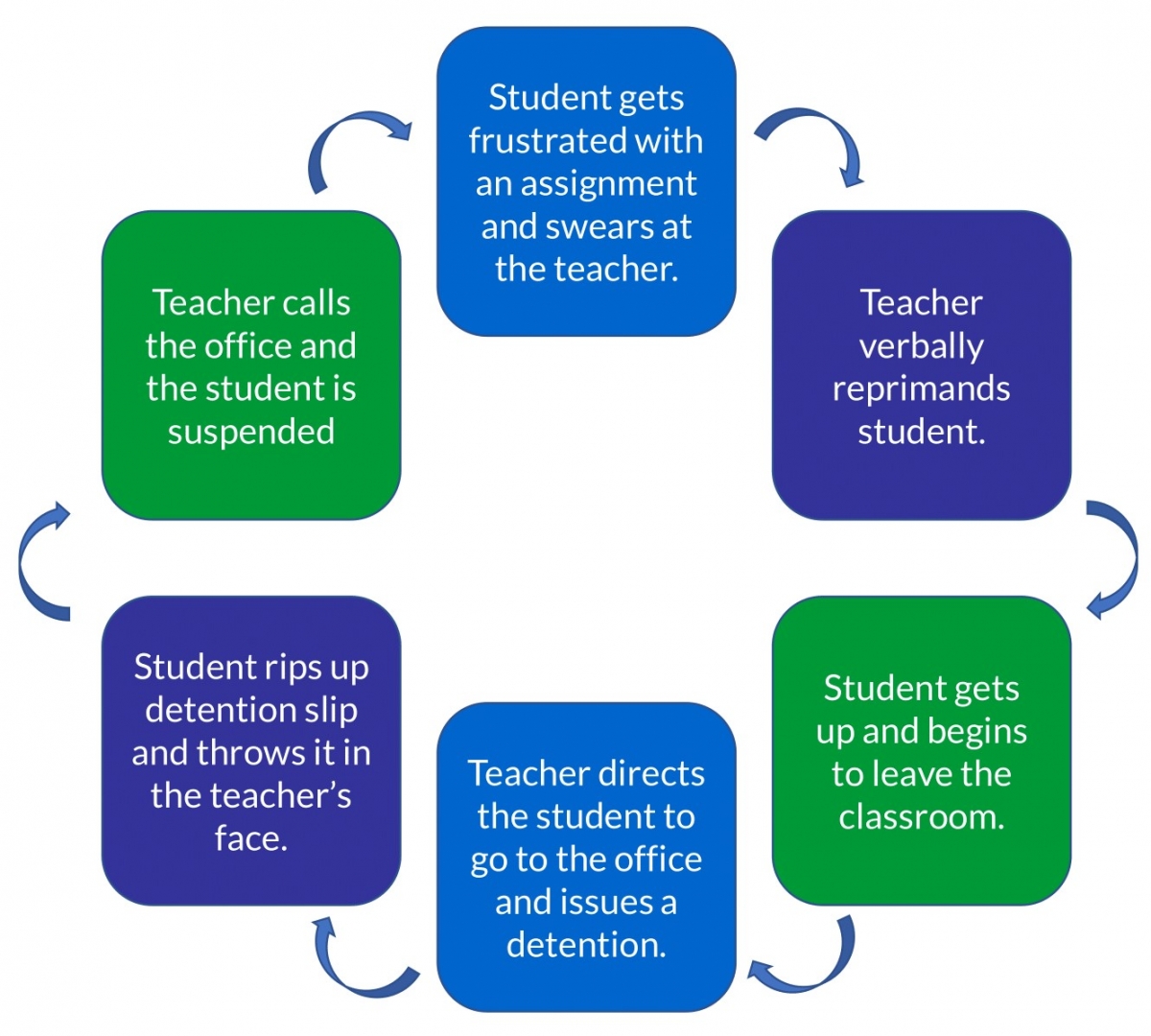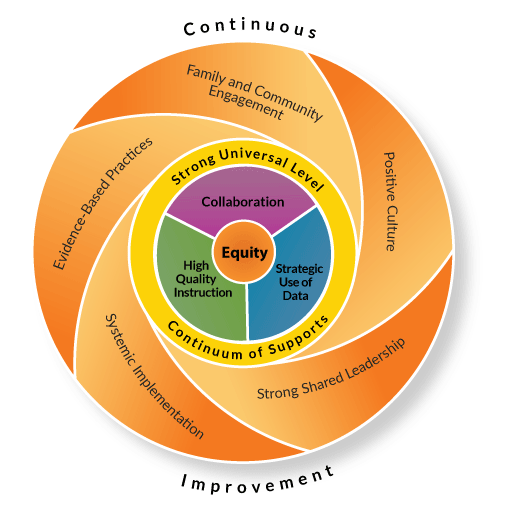Overview
When implementing inclusive strategies to address significant behavioral needs for students with IEPs, adults want to ensure the use of proactive and positive behavioral interventions and supports that teach mutually agreed upon expectations and result in desired learning outcomes and skills. Proactive and positive interventions and supports should be specifically designed to effectively address a student’s unmet needs, lack of skills, or unsolved problems that are the root cause of why a student’s behaviors interfere with the student’s learning or the learning of others. These interventions and support should also capitalize on student strengths and accomplishments.
The Individuals with Disabilities Education Act (IDEA) emphasizes the important, and at times required, role of positive behavior interventions and supports. Under IDEA, when a student’s behavior impedes the student’s learning or that of others, the IEP team must consider the use of positive behavioral interventions and supports and other strategies, to address that behavior (see 34 CFR § 300.324 and Wisconsin DPI Free Appropriate Public Education (FAPE) bulletin 18.02). Failure to address the behavioral needs of a student through the Individualized Education Program (IEP) process is likely to result in a student not receiving a Free and Appropriate Public Education (FAPE). For additional guidance see United States Department of Education Office of Special Education Programs guidance on Ensuring Equity and Providing Behavioral Supports to Students with Disabilities.
To provide proactive and positive interventions and supports, adults need to model, reinforce, and set up opportunities for students to practice new skills. Adults need to help students generalize the newly learned skills in varying contexts. At times, the adult response to a student whose behavior interferes with learning or the learning of others is grounded in the belief that the student is the problem. Rather than responding with positive support strategies, this mistaken belief may result in the use of punishment in order to “teach” the student a lesson about their misbehavior.
Punishment does not teach new skills or replacement behaviors or how to solve a problem. Punishment only serves as an attempt to stop behavior that interferes with learning in an immediate way. Adults applying punishment, or other negative consequences, in response to student behavior, can quickly cause a downward spiral as in the following example. This cycle leads to further opportunity gaps and the marginalization of students.

A proactive and positive response to behavior that interferes with learning provides a far more effective process for teaching and supporting students. Supportive strategies stimulate an upward cycle of positive interactions, safe and supportive environments, and more positive student outcomes. The focus is on anticipating the challenges a student may face across learning environments and proactively addressing the student’s needs by providing planned support and intervention before the student’s behavior escalates. In the preceding example, a completely different scenario might unfold if a plan was in place to address the student’s frustrations before the behavior escalated.

In the above example, by being proactive in responding to the student’s needs, the adult is better able to provide instruction and support that leads to the student learning new skills and becoming independent in identifying and addressing their own needs in a way that does not interfere with their learning or the learning of others.
All students benefit from a proactive and positive approach, and positive behavior interventions and supports are best when implemented within an equitable multi-level system of supports (MLSS). Within an MLSS, collaborative teams implement practices to support student social competence and academic achievement, data-driven decision making, and adult behavior. When implemented with fidelity and in a systematic manner, positive behavioral interventions and supports have a positive impact on student outcomes, both functionally and academically.
-
Research conducted over the past 15 years has shown that positive behavioral interventions and supports are effective in promoting positive behavior in students and schools. Use of such strategies to maintain pro-social behavior will make schools safer so students can more easily progress toward meeting age and grade expectations. Safer schools are more effective learning environments.
-
Schools that implement system-wide supports and interventions also report increased student time engaged in academic activities and improved academic performance.
-
Schools that employ a system-wide, proactive, and positive behavioral intervention and support indicate reductions in office discipline referrals of 20-60 percent.
-
Positive behavioral interventions and supports that are evidence-based and implemented consistently, and with fidelity, can lead to dramatic improvements that have long-term effects on the lifestyle, functional communication skills, and behavior of individuals with disabilities.
-
A review of research on the effectiveness of positive behavioral interventions and supports showed a greater than 90 percent reduction in behavior that interferes with learning in over half of the studies; with the targeted behavior completely eliminated in over 26 percent of the studies (Cohn 2000).
School-Wide Positive Behavioral Intervention and Supports (PBIS)
The systematic process of implementing positive behavioral supports on a proactive, school-wide basis is called Positive Behavioral Intervention and Supports (PBIS). PBIS applies evidence-based programs, practices, and strategies for all students to increase academic performance, improve safety, decrease problem behavior, and establish a positive school culture through a team-based problem-solving process that considers systems, data, practices, and outcomes. PBIS is part of a Equitable Multi-Level System of Supports.
Wisconsin’s Equitable Multi-level Systems of Supports (MLSS) conveys the vision of an integrated system of behavioral, social, emotional, and academic support; includes all educators and all learners; considers the whole student and system; and attends to equitable access, opportunity, and outcomes.

The Pyramid Model is a framework for implementing a culturally responsive and equitable multi-leveled system of supports designed to enhance social and emotional competence of young children, promoting the development of program policies and practices, and providing early care and education providers with practice-based coaching to ensure that evidence-based practices are integrated and used with fidelity. Please visit the Wisconsin Alliance for Infant Mental Health to learn more about the Pyramid Model, including videos, resources, and training opportunities in Wisconsin.
The Wisconsin Department of Public Instruction, through the support and guidance of Dr. Markeda Newell, has developed resources to assist educators working in problem-solving teams to identify and address bias when it shows up during collaborative problem-solving and decision-making. The Culturally Responsive Problem-Solving Framework helps adults fully understand how the relationships, communication, and expectations they establish in the learning environment either support individual student needs or further exacerbate and trigger more intense responses from a student. To view full online modules, videos, and problem-solving guides, please visit the Wisconsin DPI Culturally Responsive Problem Solving web page.
Reflection and Application Activities
The following reflection and application activities were developed to build the knowledge, skills, and systems of adults so they can assist students with accessing, engaging, and making progress in age or grade level curriculum, instruction, environments, and activities.
-
Discuss with your team which is more effective: positive behavioral interventions and support or exclusionary disciplinary practices? Include data or information to support your thinking.
-
Reflect on your views of punishment. As discussed earlier, punishment is often used to “teach the student a lesson”. Consider if there was a time when you thought a student “needs” to be “taught a lesson”.
-
What behaviors trigger this thinking, what students do you most often believe need to be taught a lesson (boys, Black students, etc.).
-
How does understanding the conditions under which you think a student needs to be punished more effectively interrupt this thinking and change your approach to the student’s behavior?
-
-
Identify a past experience where you or a team member supported a student over a period of a school year who demonstrated significant behaviors that interfered with the student’s learning or the learning of others.
-
If proactive and positive behavioral interventions and supports were used, what were the outcomes or results?
-
How do positive behavioral interventions and support assist students in the future for college, career, and being part of a community?
-
If only disciplinary removals or punitive actions were used, what were the outcomes or results? If not, what do you think the result would have been if only disciplinary removal or punitive actions were used?
-
Were there any positive behavioral interventions and support that did not work? Why or why not?
-
What training or support for school staff may be needed?
-
What is the benefit of all staff understanding culturally responsive problem-solving and culturally responsive practice?
-
-
-
Discuss with your team how your school-wide Positive Behavioral Interventions and Supports (PBIS) system supports students with IEPs who have significant behavioral needs.
-
How might your PBIS system be able to further support each student’s unique and individual positive behavioral interventions and support outlined in the student’s IEP?
-
What alignment do you see between intensive support provided in your school or district RtI or PBIS system that addresses intensive behavioral needs and the intensive interventions and support outlined in students’ IEPs?
-
How can special education and general education staff combine expertise to better support each and every student in the school and district?
-
-
Use the resource provided by the U.S. Office of Special Education Programs, Supporting and Responding to Behavior: Evidence-Based Classroom Strategies for Teachers, and take the self-assessment to gauge current evidence-based, positive, proactive, and responsive classroom practices.
-
Consider and discuss what strengths and needs were found in each of the essential feature areas for classroom interventions and supports:
-
Foundations
-
Practices
-
Data systems
-
-
-
Review the training activities related to culturally responsive problem-solving found in the Behavior, Bias, and Adult Practice section that is part of this series.
-
Using the Inclusive Learning Communities (ILC) Practice Profile, from the Wisconsin DPI RPIC Project, review the essential attributes of a learning environment that is inclusive of each and every learner. Consider the core competency area of Inclusive Mindsets.
-
How are adults creating a community of learners?
-
Reflect if the use in practice is Expected, Developmental or Unacceptable.
-
What are the areas of strength and needs for adults in the building?
-
Resources
Cohn, Andrea. 2001. “Positive Behavioral Supports: Information for Educators.” National Association of School Psychologists. Accessed March 11, 2021.
Office of Special Education Programs. “Dear Colleague Letter on Supporting Behavior of Students with Disabilities.” United States Department of Education. Last modified September 1, 2017.
Individuals with Disabilities Act, 34 CFR § 300.324.
Wisconsin Department of Public Instruction. “Information Update Bulletin 18.02: Free Appropriate Public Education.” Last modified June 2018.